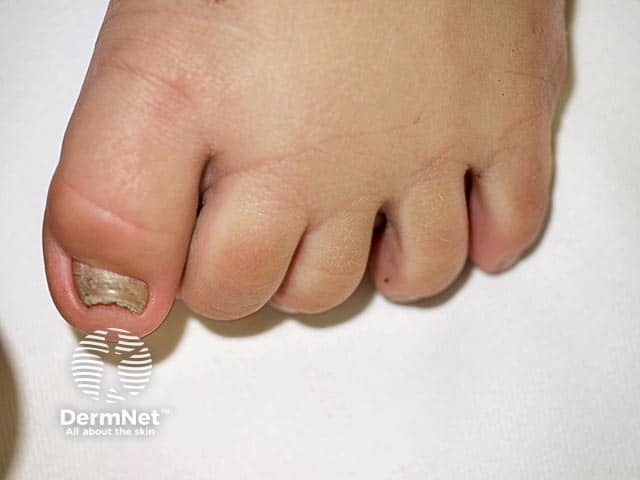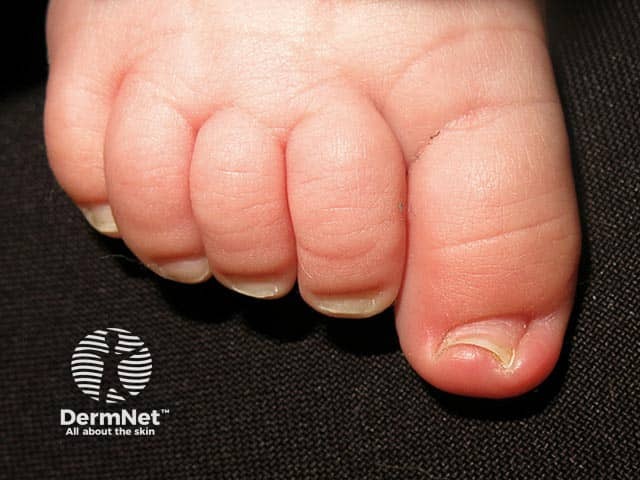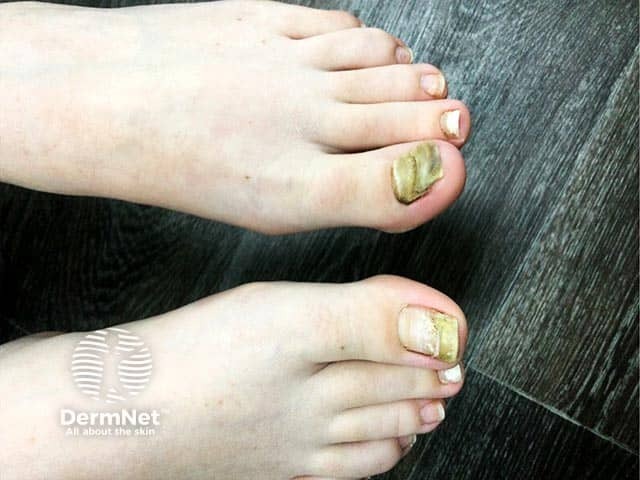Main menu
Common skin conditions

NEWS
Join DermNet PRO
Read more
Quick links
Authors: Dr Anne-Marie Aubin (Resident); Dr Kevin Phan (Dermatology Registrar); and Dr Thomas Barrett (Consultant Dermatologist), John Hunter Hospital, NSW, Australia (2022)
Reviewing dermatologist: Dr Ian Coulson
Edited by the DermNet content department
Introduction
Demographics
Causes
Clinical features
Variation in skin types
Complications
Diagnosis
Differential diagnoses
Treatment
Prevention
Outcome
Congenital malalignment of the great toenails, also known as congenital malalignment syndrome, is a dystrophic nail disorder caused by the lateral rotation of the nail matrix.
The malalignment results in alterations of the normal linear growth of the nail plate along the major axis of the distal phalanx.

Malalignment of the great toenail with lateral orientation of the long axis of the nail plate

Congenital malalignment of the great toe nail in a toddler

Congenital malalignment of the great toenail with onycholysis and subungal Pseudomonas infection causing a green nail
Congenital malalignment of the great toenails usually present at birth or in infancy. In some cases, it may not be identified until patients are older, as repetitive mechanical trauma to the nail unit over time can exacerbate subtle deviations in normal growth.
While the incidence of congenital malalignment of the great toenail is unknown, it is estimated to be observed in approximately 1–2% of children. As this condition is often misdiagnosed, higher incidence rates are suspected, and a high index of suspicion is required to diagnose chronic exacerbations of mild disease. A slight female predominance has been described.
The exact cause is not completely known. Associations include:
Clinical features include:
Further research is needed to describe features of congenital malalignment of the great toenails in darker Fitzpatrick skin types and ethnicities.
The complications of congenital malalignment of the great toenails may include:
Congenital malalignment of the great toenails is diagnosed clinically based on its characteristic appearance.
Fungal cultures from nail scrapings may be performed to exclude tinea unguium or secondary infection.
There is no established role for nail biopsy, but it may be useful to exclude other diagnoses, for example if a tumour of the nail unit is suspected.
An X‐ray of the toes can further help to determine the degree of malalignment.
Aetiology |
Differential diagnoses |
Infective |
|
Inflammatory |
|
Tumours of the nail apparatus |
|
Genetic |
|
Endocrine |
|
Drug-induced |
|
Environmental |
|
Autoimmune connective tissue diseases |
|
Traumatic or iatrogenic |
|
Treatment can be either conservative or operative depending on the cause and degree of deviation.
Conservative treatment is appropriate for minimal deviation and involves:
Operative treatment may be appropriate for severe deviations and involves:
To prevent complications, wearing proper footwear to prevent excessive nail pressure on the nail bed and avoiding repetitive traumatic injury in sports such as soccer, dancing, and long-distance running can be helpful.
Spontaneous resolution occurs in around half of those younger than 10 years. In others, the malformation may persist into adulthood, and can gradually restrict daily activities over time. In the case of severe malalignment, earlier surgery (eg, before 2 years of age) is likely to achieve better results.
Nail pathologies are often difficult to treat due to the requirement of long-term patient adherence to therapies, and recurrent macro- or micro-trauma.